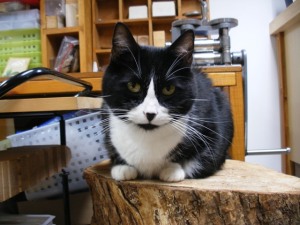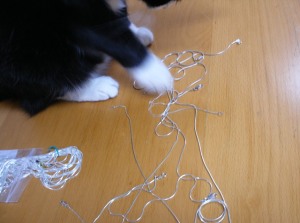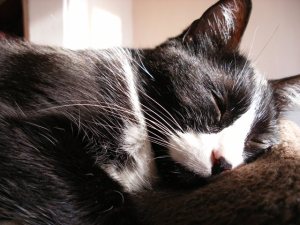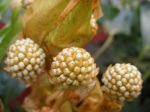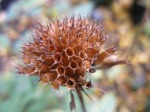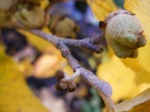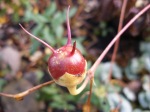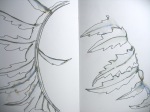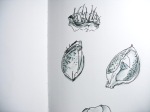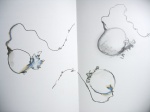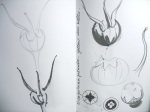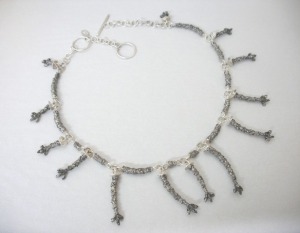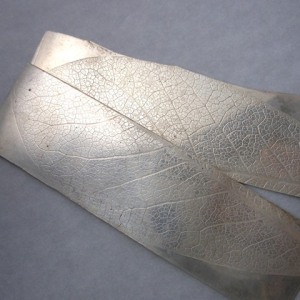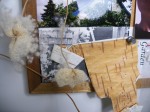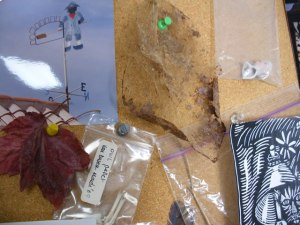The working life of a studio jeweller is pretty much a solitary one. Now that the hectic craft fair season is over, and another crop of students have been sent on their own jewellery-making journey, I am back at the bench. Clang – clang – saw – saw – the studio is alive with many sounds. No human voice is to be heard though; except for the occasional swearing (yes, sometimes metal can test your patience). This being a one-woman operation, my only companion in the studio is a tuxedo cat named Sasha.
Sasha is not allowed to be in the studio by himself. When he visits, he usually likes to sit on the window sill or on the stump that I use for hammering. From his vantage point he watches and listens. Movements, activities, sounds, nothing escapes him. He loves the rhythmic scraping of the file on metal, and the whirr of the flex shaft. He is fascinated by the torch, but because he is a well-behaved cat (generally), and because I have trained him to stay at a safe distance, he has developed a healthy respect for it, and keeps well away.
Our partnership would be perfect, except for the fact that I cannot always keep Sasha entertained or interested (Is my work not good enough?). When he gets really bored, he jumps on top of the bench, and starts pushing everything off the edge – pieces of metal, small hand tools, stones – and then lands in the scrap drawer; his paws now nicely coated with shiny silver filings. To make matters worse I sometimes let things get a little messy in my studio. In-progress pieces left out on my work table are allowed some “breathing space”; they can evolve more freely somehow. I might also leave out samples of textured sheets that could spark some ideas for a new project later on. And I find that not putting tools away encourages me to “play” with them and use them in a more creative way. There are always sketches spread out on the table, and various found objects. A little bit of mess provides a more stimulating environment and helps creative juices flow more easily. This, unfortunately, is also a very stimulating environment for a bored cat.
In a small space with a lot of tools and equipment, things could quickly get out of control and compromise your pet’s safety, and yours. In a jewellery studio, safety should always be a priority, for everyone’s sake.
There are areas of the studio that should be off-limits to your pet: soldering station (don’t leave the torch unattended, the tanks should be secured), polisher, flex shaft, ultrasonic cleaner and pickling pot. All chemicals should be stored safely in a cabinet, all containers labelled clearly. Small parts should be put in bags or containers. Sharp objects should be stored away when not in use. Chains or spools of wire (Sasha’s favorites) should be stored safely as well. Be careful with magnets (used in clasps for example). Some are very powerful and can pose serious health risks if ingested. With etching, make sure your pet is not around. Period.
Charles Lewton-Brain has written extensively on studio safety. He has published numerous articles on this subject; several can be found at: www.ganoksin.com.
His book, The Jewelry Workshop Safety Report (ISBN 0-9698510-4-9), is very comprehensive and deals specifically with safety in the goldsmith’s studio. And don’t forget to consult MSDS sheets (Material Safety Data Sheets) to find out how to handle and use products and chemicals safely. They are available online.
The holidays are fast approaching. So what to get the cat who is not on the naughty list?
What about a Charming Collar for a Lucky Cat?

Dominique Bréchault – Charming Collar for a Lucky Cat – Gold plated copper, silver, crystals. Fabricated, cast. Charms: Fish, bird, food bowl, number 9, yarn, cheese and mouse)
Best wishes to all for a prosperous, creative and safe New Year!
N96UFVNG3A3C


